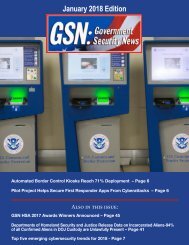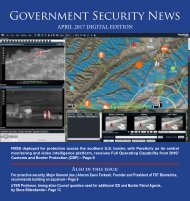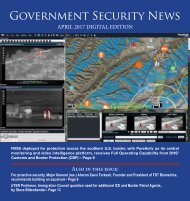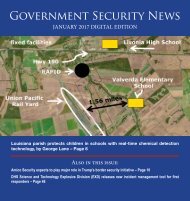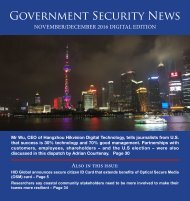Government Security News July 2016 Digital Edition
Government Security News, founded in 2001 shortly after 9/11, is a news and feature publication covering Homeland Security and Defense. It is read by government executives in federal, state, county, municipal agencies as well as technology vendors and service personnel in Law Enforcement, Airport and Aviation Security, Border Security and Immigration, Maritime and Port Security, Disaster Preparedness and Response, Counter-Terrorism, IT and Cybersecurity and all other branches of Government and the Military. In addition to its daily, weekly and monthly publications and newsletters, Government Security News also operates two awards programs that are well-respected in the U.S. and Internationally.
Government Security News, founded in 2001 shortly after 9/11, is a news and feature publication covering Homeland Security and Defense. It is read by government executives in federal, state, county, municipal agencies as well as technology vendors and service personnel in Law Enforcement, Airport and Aviation Security, Border Security and Immigration, Maritime and Port Security, Disaster Preparedness and Response, Counter-Terrorism, IT and Cybersecurity and all other branches of Government and the Military. In addition to its daily, weekly and monthly publications and newsletters, Government Security News also operates two awards programs that are well-respected in the U.S. and Internationally.
You also want an ePaper? Increase the reach of your titles
YUMPU automatically turns print PDFs into web optimized ePapers that Google loves.
The Need for a National Energy<br />
Grid Strategy<br />
by J. Michael Barrett<br />
U.S. energy consumers have been<br />
able to count on reliable, alwayson<br />
and relatively resilient electrical<br />
power for so many decades that for<br />
most people the availability of electrical<br />
power is essentially taken as a<br />
given. And yet there is a looming<br />
sense among many experts of a rise<br />
in systemic risks that have begun to<br />
come into the light, ranging from<br />
threats of physical and cyber attack<br />
to space weather and other natural<br />
phenomenon. Indeed, just last year<br />
the Department of Defense released<br />
a request for proposals involving<br />
resilient electrical power that led to<br />
a recent commentary noting, “The<br />
declaration of DOD is clear:<br />
military bases and the civilian<br />
institutions that they depend<br />
on are overwhelmingly vulnerable<br />
to their own near complete<br />
reliance on unprepared<br />
civilian power grids. The DOD<br />
has already started the process<br />
of changing by developing distributed<br />
energy systems under<br />
their own control.”<br />
And yet the U.S. electric<br />
power grid remains indispensable<br />
for continued American prosperity<br />
and well-being, even as the<br />
grid’s infrastructure is aging and<br />
increasingly outdated. The massive<br />
capital needs of this enormous<br />
system require constant investment<br />
and occasional system-wide overhauls.<br />
These represent a particular<br />
concern for the investor-owned<br />
electric utilities, for whom making<br />
the business case for higher rates<br />
to enable investments just to tread<br />
water is hard enough, much less investments<br />
meant to innovate and<br />
implement large-scale modernization<br />
programs.<br />
At the same time, the grid is a very<br />
large system, with a long list of items<br />
that need to be replaced for a variety<br />
10<br />
of reasons including: physical wear<br />
and tear, technical obsolescence,<br />
and the critical importance of meeting<br />
the security and power surety<br />
needs of Americans in the 21st century.<br />
This includes everything from<br />
integration of environmentally<br />
friendly alternative means of power<br />
generation to replacing the beyondexpected-service-life<br />
equipment<br />
such as the large power transformers,<br />
as well as the two-way communications<br />
built into smart meters<br />
and making the move towards interchangeable<br />
parts and other standardizations<br />
that increase efficiency<br />
of ‘spares and repairs.’<br />
While the concerns over a truly<br />
resilient and “disaster-proof ” electrical<br />
power system are on the<br />
rise, however, there is no central<br />
effort to develop a smart<br />
roadmap to get the nation from<br />
where we are to where we need<br />
to be. Part of the problem is<br />
bureaucratic – there are multiple<br />
competing equities among<br />
the Departments of Energy,<br />
Homeland <strong>Security</strong>, and Defense,<br />
and that is just on the<br />
federal side. The power grid is<br />
More on page 43




